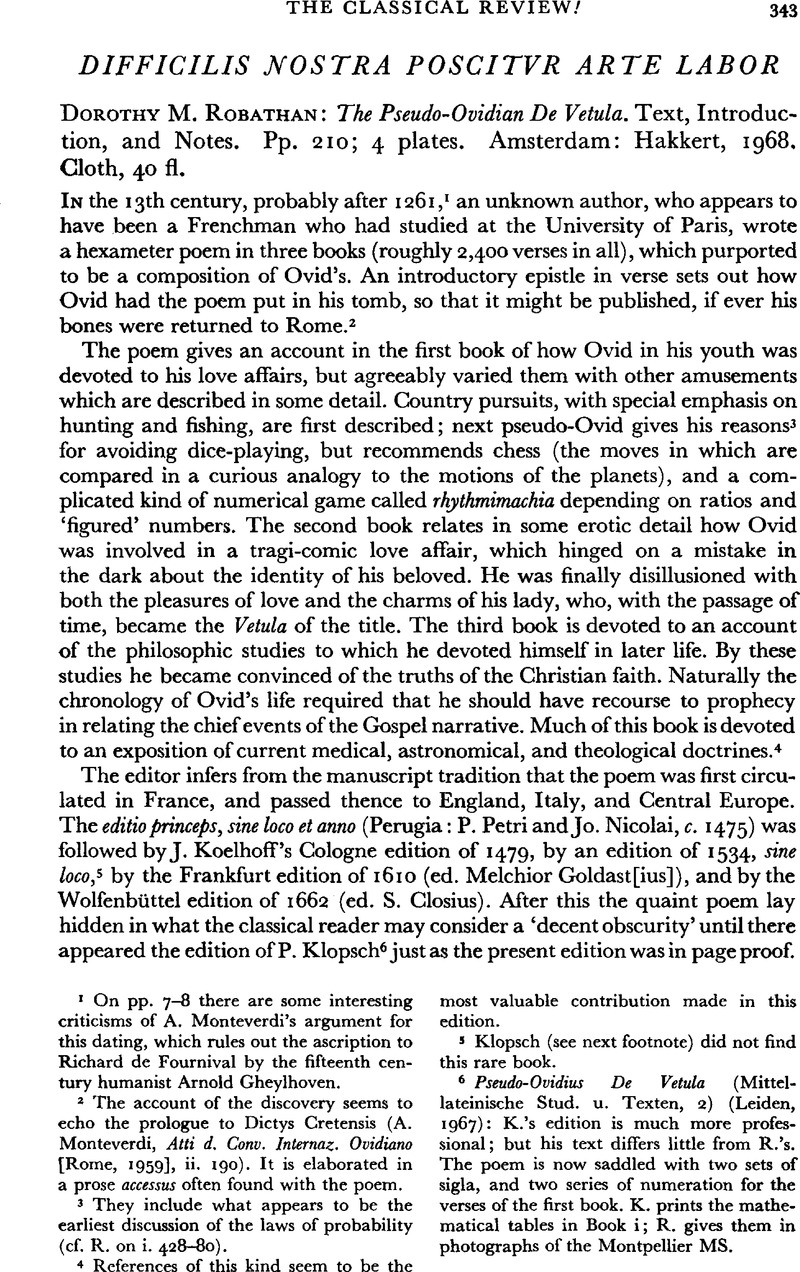Article contents
Difficilis Nostra Poscitvr Arte Labor - Dorothy M. Robathan: The Pseudo-Ovidian De Vetula. Text, Introduction, and Notes. Pp. 210; 4 plates. Amsterdam: Hakkert, 1968. Cloth, 40 fl.
Published online by Cambridge University Press: 27 February 2009
Abstract

- Type
- Reviews
- Information
- Copyright
- Copyright © The Classical Association 1970
References
page 343 note 1 On pp. 7–8 there are some interesting criticisms of A. Monteverdi's argument for this dating, which rules out the ascription to Richard de Fournival by the fifteenth century humanist Arnold Gheylhoven.
page 343 note 2 The account of the discovery seems to echo the prologue to Dictys Cretensis (Monteverdi, A., Atti d. Conv. Internaz. Ovidiano [Rome, 1959], ii. 190)Google Scholar. It is elaborated in a prose accessus often found with the poem.
page 343 note 3 They include what appears to be the earliest discussion of the laws of probability (cf. R. on i. 428–80).
page 343 note 4 References of this kind seem to be the most valuable contribution made in this edition.
page 343 note 5 Klopsch (see next footnote) did not find this rare book.
page 343 note 6 Pseudo-Ovidius De Vetula (Mittellateinische Stud. u. Texten, 2) (Leiden, 1967): K.'s edition is much more professional; but his text differs little from R.'s. The poem is now saddled with two sets of sigla, and two series of numeration for the verses of the first book. K. prints the mathematical tables in Book i; R. gives them in photographs of the Montpellier MS.
page 344 note 1 Despite some extensive contamination Klopsch gives a stemma; and he covers almost the whole tradition in his apparatus, giving the readings of 58 codices (of which 45 are common to both editions, while R. has three not listed by K.).
page 344 note 2 At ii. 693 there is no reference to the diagram that K. reproduces.
page 344 note 3 The indexing is slovenly: Ih'm (the nomen sacrum) is so printed in text and index (!); particles are not included; dare, habere, and dicere are not included (though dictare is); und(a)e (i. 280), noua (ii. 495), etc. are omitted; the index gives accomodet (iii. 78), the text accommodet (but K. accomodet); derived forms are sometimes grouped together, sometimes not.
page 344 note 4 Consonantal h would suggest a Germanic author.
page 344 note 5 Oxford, 1913 (p. 507).
page 344 note 6 ‘Felix qui Horace Odes I. 13. 17’ (wrong) ‘Maximianus I. 289’ (note on i. 214). If any source is needed for this trite pair of words, Ov. Am. ii. 5. 9 and Virg. Georg. ii. 490 are much more likely.
page 345 note 1 Klopsch sets out many in his apparatus of parallels; add (e.g.) ii. 426 parallel to Virg. Aen. ii. 265 etc.
page 345 note 2 Efficiently treated by K. (pp. 106–15).
page 345 note 3 Note on ii. 187: ‘examen = exemplum’.
page 345 note 4 At ii. 248 timpora (ARSF) is preferred to tempora (MVL)—no comment.
page 345 note 5 On equidialis (iii. 192) it is observed that other authors have equinoctialis. The metrical reason is not pointed out.
page 345 note 6 Neither K. nor R. has printed the Latin text without blemishes. I hope pars dātur (ii. 396, parsque datur K.) is a misprint.
- 1
- Cited by




